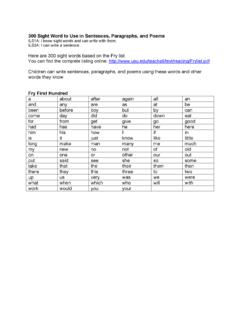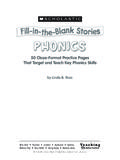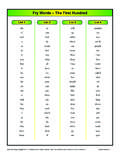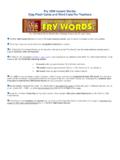Transcription of Packet - PGCPS
1 ExtraSummer ResourcePacketFor Pre-K through 1st GradeTable of (~ontentsLooking ahead to next fall - what your child should know ..4 Daily activities ..5 sight word lists ..7 Educational Web sites ..10 Recommended reading list and reading log ..13 Additional ResourcesAlphabet letter / sound chart100s charts and reading comprehension graphic organizersLocal Summer Programs and Services2 What your child should know for the firstday of first gradeIndependent SkillsPerform all personal care including: tying shoes, tucking in shirt properly, button/snap/zip pants,buckle 10 minutes a Recognize ALL uppercase and lowercase letters (make flashcards)- Know the sounds of ALL consonant letters (A-Z) and the short vowelsHigh Frequency words - should know all Kindergarten words by sight and be familiar with first grade words .)
2 **See attached for complete word listWriting- Write 3 sentences independently with spacing, punctuation and capitalization. (Every word isrepresented - even if it isn t spelled correctly - by letters that the student hears when sounding itout.)- Practice correct formation of upper and lowercase letters and numbers. (Make sure your child isstarting at the top of the letters/numbers and not the bottom.)** Website: by ls, 5s and 10s to 100 Count by 2s to 20 (40 would be even better)Recognize penny, nickel, dime, and quarter and know their value in centsKnow shapes -circle, square, rectangle, and triangle (2D); cube, cylinder, cone (3D)Tell time to hour and half hourRecognize, describe and create patternsKnow the days of the week and months of the year- Count objects up to twentyMathEvery day-Count to 100 - by I s, 2 s, 3 s, 5 s and 10 and subtraction problems (for beginners, write and draw a picture to solve;for advanced, practice with flash cards).
3 -Sing the days of the week the months of the year the time on digitat and analog clocks. Tell how you know what time it your parents to see the coins they have in their pocket. Sort them, say what eachone is (penny, nickel, dime or quarter) and say how much it is. If you can, add up howmuch money the coins make all the opportunity arises- Maize sure your child sees you using math as you go through your day. Talk out loudabout what you are measuring or figuring. Say: "1 need to double this recipe. Let s see, Icup plus I cup is two cups. If the recipe says 2 teaspoons of baking powder, how muchwill we need if we double it?"-Write your numbers to a ruler and measure things around your house. Record your measurements andshare the results with somebody, including the longest and shortest objects you FractionsmMake fractions fun.
4 Fold paper towels or napkins into large andsmall fractions. Start with halves and move to eighths and sixteenths. Use magic markersto label the put away groceries. Identify the shapes of the containers - cubes, rectangularprisms, pyramids, spheres, and cylinders. Notice which ones stack, slide and measure the ingredients in food for set the timer for dinner. After some time goes by, check how much time is leftand how long the food has already been a map of your neighborhood or other places you go over the summer. Label theroads and keep track of how many miles you travel in the car or on your how long it takes you to get a mile in the car, on your bike, and on foot. Make achart to see which is fastest and by how many your parents weigh fruits and vegetables at the groce~ store.
5 Guess how much itwill weigh before you even put it on the scale. Compare the actual weight with yourestimate. Compare fruits and vegetables by holding one in each hand and then weighthem to see which actually weighs more and by how day-Read a book. Retell the story to how many sight words you can read off of the lists in this sentences using your sight words to tell about your day in a sure your child sees you reading and writing as you go through your day. Talkabout what you read and write so your child can hear. Say: "1 have to use a capital letterat the beginning of this sentence." Tin not sure how to spell this word. I ll say it slowlyand listen for the sounds I hear." Tm asking Dad a question in this note, so I d betteruse a question mark.
6 "-Help your child learn to use more interesting words when speaking and writing. Whens/he uses a common word like "nice" or "big," challenge him or her to think of someother words that mean the same thing. Ask, "What other words could you use insteadof nice when you are talking about something you like?"When the opportunity arises-Read a book. Draw and write about your favorite a book. Draw a part of the book that reminded you of something in your draw what it reminded you of. Write how the book connected with, andreminded you of, something in your a book. Write three sentences explaining why you liked it or didn t like a book. Think of questions you have as you are reading. Write them down onpost-its and come back to them when you are finished with the book to see if they wereanswered.
7 (Use "1 wonder" or "How come" to start out your questions.)-Have a family member say words and you try to sound them out and spell them - thenhave someone check them over to show you what you missed and celebrate what yougot right!-Think of as many verbs as you can and act them of as many describing words (adjectives) as you can to talk about someone youknow or something you did. Think of all of your senses when you are describing -sights, sounds, smells, textures (touch), and on a word scavenger hunt. Circle all the words you know in a newspaper ormagazine and then read them to someone to show how smart you are!-Use sidewalk chalk to write your sight hiking in nature or walking through your neighborhood, ask your child todescribe what s/he sees.
8 Can s/he tell you a story about it? Listen carefully, and askquestions to extend the story." But how did the kitty get there?" "What could have lefta footprint like that?"-Go through your house with your child and label everyday objects. For example, table,chair, sink, window, bookshelf and so on. Read the labels with your child. Each day, adda few more labels around the house. After awhile, copy the labels to a sheet of paperand ask your child to read them with you. Then go on a word hunt and find the itemsthroughout the ~gaRen Word Rec~%Jnition Listalikeamtookandmeoremyatnocanplaydosa idforseegoshehavethehetohereupIweiswilli tyou7verycouldandareafteratbecausebutcom eforfromgoinggothadhaveheherputFirst Grade Word Listdownhimmakelookamtodayisovermemyofon whatoutsaidsawsheherewiltlittlethatthewh erethentheretheythislikeupwasROWwentwere withyouyourExtra Dolch wordsawayateagainalwaysbigbeanaroundfind cameanybeenfunnydidasbeforehelpdoaskbest ineatbybothjumpgeteverybuynotgoodflycall toointogivecoldundermusthasdoeswantnewhi sdon
9 Twellourhowfastwhopleasejustfoundyespret tyknowgaveopenranletgoesroundrideliveifs omesaymaymadestopsooldmanytakesoononceof faboutbetterbringcarrycleancutdonedrawdr inkfallfarfullgrowholdhurtitskindlaughmy selfthankthemthinkwalkwhenpulltheirthese thoseuponwhichwhywouldneveronlyownstartt ogethertry9 tucational Web Site Use these websites to practice the skills necessary for success in Ist SitesStudy personalized practice through games and activities at your level (Uses an assessment toolto gauge progress and keep track of skills that are mastered.) Also, try to beat your classmates"high scores!PBS games and watch educational videos games that work on reading and math Schoolsv~ educational games wealth ofworksheets and online activitiesPBS Teacher Source and PBS for teachers, I~ds and parents, connected to your child s favorite PBS Department of Education, Office of Educational Research and bs/parentsPrint and Learn for downloadable and printable worksheets, sorted by grade levelLearning Disabilities Onlinewww.
10 ~don~ resources for parents whose children struggle with learning or learning disabilities. Searchv~th keyword, "reading. "10 Math activities, problem of the day and online manipulatives (like pattern blocks).A plus your own flashcards or play addition and subtra~on games Math 4 math games online and work on addition, subtraction, fractions and other math Math for students, parents, and teachers. A related Website, MathWorld Interactive, givesstudents open-ended word problems flash cards with a variety of options and mathematical : National Council of Teachers of Mathematics (NCTM)http://illu plans and math tools based on NCTM s Principles and Standards for math courses, daily math activities, and resources you can worksheets, software, and puzzles you can and Learn for downloadable and printable worksheets, sorted by grade levelReadin_~ SitesThink books for children to read in pdf books and answer comprehension free downloadable leveled readers, should read on level E or above.













